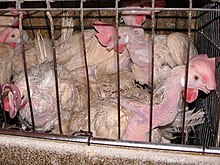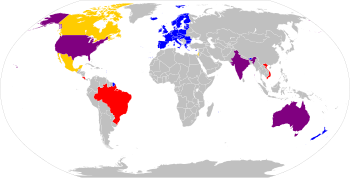层叠笼

层叠笼(英語:Battery cage)或称炮台笼,是动物养殖中使用的一种笼子,主要用于蛋鸡饲养。层叠笼在动物福利方面存在许多争议。
应用[编辑]
层叠笼在世界各地的畜牧业中被广泛应用。[1][2][3] 它可以减少母鸡之间的相互攻击,但同时也限制了动物的活动,阻止了许多自然的行为,并增加了动物患上骨质疏松症的概率。[3] 在2014年,美国大约95%的鸡蛋都来自于生活在层叠笼中的母鸡。[4] 根据英国环境、食品和乡村事务部的数据,2010年在英国销售的鸡蛋中有50%来自生活在笼子里的母鸡,45%来自散养鸡,5%来自谷仓饲养的鸡。[5]
动物福利[编辑]
层叠笼在动物福利方面存在许多争议,以下是大致按照母鸡生活史排列的影响:
雏鸡淘汰[编辑]
由于现代对动物的人工选择,蛋鸡与肉鸡为不同分型。因此在蛋鸡饲养中,无法产蛋的雄鸡也不适合作为肉鸡,它们往往在出生时就被宰杀。[6] 宰杀方式包括断颈、用二氧化碳窒息或是用高速滚筒碾碎。
动物权利组织通过影片记录了雏鸡被高速滚筒碾碎的残酷情景。[7] 断颈、窒息和碾碎都是美国兽医协会认可的雏鸡安乐死程序。[8][9]
断喙[编辑]
为减少啄羽、残杀、啄肛等行为,大多数被安置于层叠笼中的鸡都被断喙。通常在母鸡出生的第一日就被断喙,这一过程与性别筛选、接种疫苗同时进行。许多科学家认为,断喙会造成强烈的疼痛,并且可能带来长期的慢性疼痛;断喙是所有鸡类养殖系统共同的步骤,不限于层叠笼养殖。[10]
笼子尺寸[编辑]

雏鸡在大约16周时被放进层叠笼,此时它们还未有产蛋能力。在有相关立法的国家,法律规定每只鸡所占笼子面积需要在300 cm2以上不等。根据欧洲2003年制定的标准,每只鸡所占面积应大于550 cm2。[11] 美国对此的推荐标准是每只鸡67-86 in2(430-560 cm2)。[12] 一只鸡在笼中所占面积往往被描述为一张A4纸大小(624 cm2)[13] 根据另一些描述,一只典型的层叠笼大约有文件柜抽屉那么大,其中可容纳8到10只母鸡。[14][15]
行为研究指出,母鸡转身所需的面积在540-1006 cm2,展翅所需面积在653-1118 cm2,抖羽所需面积在676-1604 cm2,整理羽毛所需面积在814-1240 cm2,地面啄食所需面积在540-1005 cm2。[16] 因此,当母鸡在平均面积小于550 cm2的笼子居住时,它们的行为必然会干扰到其它个体。这种生活空间限制受到了动物福利科学家的批评。[17] 此外,还有观点指出,层叠笼单调、充满压力的环境会抑制母鸡自然行为的展现。[18] 空间限制会引发一系列异常行为,会对母鸡自身以及笼中其它同伴造成伤害。
光照控制[编辑]
层叠笼所处的环境通常保持低光照(例如小于10 lx),以减少母鸡之间的啄羽、残杀、啄肛等行为。低光照也引发了动物福利者的担忧,因为母鸡通常偏好在明亮的环境中进食。[19] 在明亮环境中,母鸡行为较为活跃,黑暗环境则相反。[20] 此外,采集鸡蛋时的突然的光照会惊吓到母鸡,促使发生啄羽行为,[21] 增加受伤风险。
层叠笼位于室内环境,其中的母鸡无法获得太阳光。尽管尚未有科学证据指出这是否对母鸡的健康有伤害,但许多动物福利倡导者仍表达了他们的忧虑。[22]
骨质疏松症[编辑]
多个研究指出,在产蛋时期(大约72周龄),母鸡对钙的需求加上缺乏运动会造成骨质疏松。在母鸡的系统性养殖业中都存在这个问题,但在层叠笼环境中尤为普遍,因此这个问题也被称为“层叠笼骨质疏松症”。[23] 骨质疏松可能会进一步引发骨折,尤其是腿部和龙骨突骨折。研究显示大约有24.6%的层叠笼环境母鸡最近遭受龙骨突骨折,相比之下较好的笼子、谷仓、散养的骨折率分别为3.6%,1.2%和1.3%。不过,层叠笼环境中的母鸡较少遭受旧骨折复发的影响(层叠笼17.7%,谷仓为69.1%,散养59.8%,其它笼子31.7%)[10]
强制换羽[编辑]
当母鸡产蛋能力下降时,饲养者可能先不会宰杀它们,而是令它们强制换羽。
相关条目[编辑]
参考文献[编辑]
- ^ Van Horne, P.L.M.; Achterbosch, T.J. Animal welfare in poultry production systems: impact of EU standards on world trade. World's Poultry Science Journal. 2008-03-01, 64 (1). ISSN 0043-9339. doi:10.1017/S0043933907001705.
- ^ Leenstra, F.; Ten Napel, J.; Visscher, J.; Van Sambeek, F. Layer breeding programmes in changing production environments: a historic perspective. World's Poultry Science Journal. 2016-03-01, 72 (1). ISSN 0043-9339. doi:10.1017/S0043933915002743.
- ^ 3.0 3.1 Meseret, S. (2016). "A review of poultry welfare in conventional production system". Livestock Research for Rural Development. 28 (12).
- ^ Greene, J.L.; Cowan, T (2014). "Table Egg Production and Hen Welfare: Agreement and Legislative Proposals" (PDF). CRS Report for Congress. 42534. Archived from the original (PDF) on 11 February 2017. Retrieved 11 February 2017.
- ^ Ranger News - 50percent of uk eggs laid by free range hens. web.archive.org. 2016-04-04 [2022-07-14]. 原始内容存档于2016-04-04.
- ^ "Egg laying and male birds". Vegsoc.org. Archived from the original on 22 February 2009.
- ^ Video Shows Chicks Ground Up Alive at Egg Hatchery. Associated Press. 2015-03-25 [2022-07-14]. (原始内容存档于2022-07-14) (美国英语).
- ^ AVMA Guidelines for the Euthanasia of Animals Archived 12 July 2012 at the Wayback Machine
- ^ Executive Board meets pressing needs - September 15, 2006 Archived 24 May 2012 at the Wayback Machine
- ^ 10.0 10.1 Sherwin, C.M., Richards, G.J and Nicol, C.J., (2010). Comparison of the welfare of layer hens in 4 housing systems in the UK. British Poultry Science, 51(4): 488-499
- ^ Appleby, Michael C. Chickens: Layer Housing. Routledge Handbooks Online. 2011-02-01. ISBN 978-1-4398-0932-7. doi:10.1081/e-eas2-120019534 (英语).
- ^ United Egg Producers (2010). "Animal Husbandry Guidelines for U.S. Egg Laying Flocks (页面存档备份,存于互联网档案馆)" (PDF).
- ^ Compassion Over Killing > Washington Post Profiles COK!. web.archive.org. 2012-12-03 [2022-07-14]. 原始内容存档于2012-12-03.
- ^ Singer, Peter. In defense of animals : the second wave. Malden, MA: Blackwell Pub. 2006. ISBN 1-4051-1940-3. OCLC 58985992.
- ^ Becker, Elizabeth. Advocates for Animals Turn Attention to Chickens. The New York Times. 2002-12-04 [2022-07-14]. ISSN 0362-4331. (原始内容存档于2012-11-05) (美国英语).
- ^ Dawkins, Marian Stamp; Hardie, Sylvia. Space needs of laying hens. British Poultry Science. 1989-06-01, 30 (2). ISSN 0007-1668. doi:10.1080/00071668908417163.
- ^ Nicol, C.J. and Dawkins, M., (1989). No room for manoeuvre. New Scientist, 16 September 1989
- ^ Mench, Joy A.; Hughes, Barry O. Poultry behaviour and welfare. Wallingford, Oxfordshire, UK: CABI Pub. 2004. ISBN 0-85199-667-1. OCLC 53485412.
- ^ Prescott, N.B.; Wathes, C.M. Preference and motivation of laying hens to eat under different illuminances and the effect of illuminance on eating behaviour. British Poultry Science. 2002-05-01, 43 (2): 190-195. ISSN 0007-1668. PMID 12047081. doi:10.1080/00071660120121382.
- ^ Davis, N J; Prescott, N B; Savory, C J; Wathes, C M. Preferences of Growing Fowls for Different Light Intensities in Relation to Age, Strain And Behaviour. Animal Welfare. 1999-08-01, 8 (3): 193-203.
- ^ Green, L. E.; Lewis, K.; Kimpton, A.; Nicol, C. J. Cross-sectional study of the prevalence of feather pecking in laying hens in alternative systems and its associations with management and disease. The Veterinary Record. 2000-08-26, 147 (9): 233-238 [2022-07-14]. ISSN 0042-4900. PMID 11014485. doi:10.1136/vr.147.9.233. (原始内容存档于2022-10-01).
- ^ Against Animal Cruelty Tasmania (AACT) - Battery Hen Campaign Archived 20 September 2011 at the Wayback Machine
- ^ Scientific Veterinary Committee of the European Commission (1996). "Report on the Welfare of Layer Hens" (PDF). Archived from the original (PDF) on 26 September 2006.

